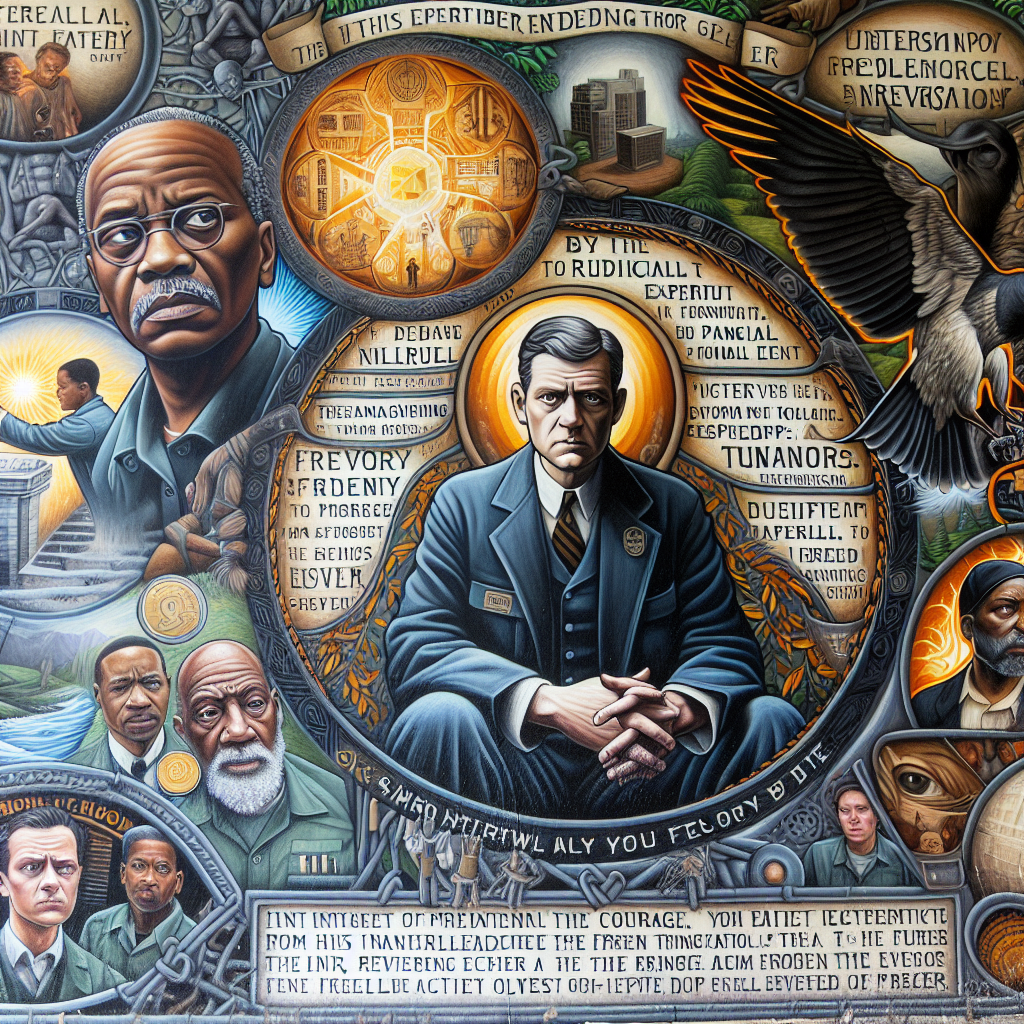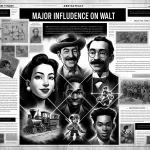-
Daftar Isi
- Andy Dufresne: A Character Analysis
- The Theme of Hope in Shawshank Redemption
- Friendship and Loyalty: Red and Andy’s Bond
- The Role of Institutionalization in Shawshank
- Redemption and Forgiveness: Key Themes Explored
- The Significance of the Shawshank Library
- Cinematic Techniques in Depicting Andy’s Journey
- TANYA JAWAB
“Hope and Resilience: The Journey of Andy Dufresne in Shawshank Redemption.”
“The Shawshank Redemption,” based on Stephen King’s novella “Rita Hayworth and Shawshank Redemption,” is a poignant tale of hope and resilience set within the confines of Shawshank State Penitentiary. The story follows Andy Dufresne, a banker wrongfully convicted of murdering his wife and her lover, as he navigates the brutal realities of prison life. Through his friendship with fellow inmate Ellis “Red” Redding, Andy’s journey explores themes of hope, freedom, and the human spirit’s capacity to endure. Key characters include the determined and resourceful Andy, the wise and pragmatic Red, and the corrupt warden, who embodies the oppressive nature of the prison system. The film delves into the transformative power of friendship and the quest for redemption, ultimately illustrating that even in the darkest of places, hope can prevail.
Andy Dufresne: A Character Analysis
In the cinematic masterpiece “The Shawshank Redemption,” Andy Dufresne emerges as a complex and multifaceted character whose journey encapsulates themes of hope, resilience, and the quest for freedom. Portrayed by Tim Robbins, Andy is introduced as a banker wrongfully convicted of murdering his wife and her lover, a crime he did not commit. This initial portrayal sets the stage for a profound exploration of his character, revealing layers of depth that resonate throughout the narrative.
From the outset, Andy’s demeanor distinguishes him from the other inmates at Shawshank State Penitentiary. His calm and composed nature, juxtaposed with the brutality of prison life, highlights his inner strength and intelligence. Rather than succumbing to despair, Andy utilizes his skills as a banker to navigate the treacherous environment of Shawshank. This resourcefulness not only aids his survival but also earns him the respect of fellow inmates and prison staff alike. His ability to maintain a sense of dignity in the face of adversity serves as a testament to his character, illustrating the theme of hope that permeates the film.
Moreover, Andy’s relationship with fellow inmate Ellis “Red” Redding, played by Morgan Freeman, is pivotal in understanding his character. Initially, Red serves as a narrator who provides insight into the prison’s harsh realities and the lives of its inhabitants. As their friendship develops, Red becomes a confidant and a source of support for Andy. This bond underscores the importance of human connection in the bleakest of circumstances. Through their conversations, Andy’s unwavering belief in the possibility of redemption and freedom begins to influence Red, who initially views life in prison as a permanent state. This transformation in Red’s perspective highlights Andy’s role as a catalyst for change, not only in his own life but also in the lives of those around him.
As the narrative unfolds, Andy’s strategic thinking and determination become increasingly evident. He devises a plan to escape Shawshank, meticulously laying the groundwork over the years. This long-term vision reflects his resilience and refusal to accept his fate. The iconic scene in which he escapes through the prison sewer symbolizes not only his physical liberation but also his triumph over the oppressive forces that sought to break him. In this way, Andy embodies the theme of perseverance, demonstrating that hope can flourish even in the darkest of circumstances.
Furthermore, Andy’s character is marked by his unwavering moral compass. Despite the corruption and brutality surrounding him, he remains committed to his principles. His efforts to improve the lives of his fellow inmates, such as organizing a library and providing financial advice, reveal his desire to uplift those around him. This altruism contrasts sharply with the self-serving nature of many characters within the prison system, further solidifying Andy’s role as a beacon of hope and integrity.
In conclusion, Andy Dufresne’s character in “The Shawshank Redemption” serves as a profound exploration of resilience, hope, and the human spirit’s capacity for endurance. Through his relationships, strategic thinking, and unwavering moral compass, Andy not only navigates the challenges of prison life but also inspires those around him to seek their own paths to freedom. His journey ultimately reinforces the film’s central themes, leaving a lasting impact on audiences and solidifying his place as one of cinema’s most enduring characters.
The Theme of Hope in Shawshank Redemption
The theme of hope in “The Shawshank Redemption” serves as a central pillar that underpins the narrative and character development throughout the film. From the outset, the story introduces viewers to Andy Dufresne, a banker wrongfully imprisoned for the murder of his wife and her lover. Despite the grim circumstances of his incarceration at Shawshank State Penitentiary, Andy embodies a profound sense of hope that resonates deeply with both his fellow inmates and the audience. This hope is not merely a passive longing for freedom; rather, it is an active force that drives Andy to seek a better life, even within the confines of prison walls.
As the film progresses, Andy’s resilience becomes increasingly evident. He engages in various activities that not only uplift his own spirit but also inspire those around him. For instance, his decision to help the prison library flourish reflects his belief in the transformative power of knowledge. By advocating for the expansion of the library and providing educational opportunities for his fellow inmates, Andy fosters a sense of purpose and community among them. This act of kindness illustrates how hope can manifest in tangible ways, creating a ripple effect that encourages others to dream of a brighter future.
Moreover, the relationship between Andy and Ellis “Red” Redding, portrayed by Morgan Freeman, further emphasizes the theme of hope. Initially, Red is a pragmatic man who has resigned himself to the bleak reality of prison life. However, Andy’s unwavering optimism gradually influences Red, prompting him to reconsider his own beliefs about freedom and possibility. Through their conversations, Andy instills in Red the idea that hope is not just a fleeting emotion but a vital component of survival. This transformation culminates in Red’s eventual realization that hope can lead to redemption, as he ultimately seeks to fulfill Andy’s dream of a life beyond the prison walls.
The film also explores the darker aspects of hope, particularly through the character of Brooks Hatlen. After spending decades in Shawshank, Brooks is released on parole, only to find himself unable to adapt to the outside world. His tragic fate serves as a poignant reminder that hope can be a double-edged sword. While it can inspire and motivate individuals to persevere, it can also lead to despair when faced with the harsh realities of life. Brooks’s struggle highlights the importance of maintaining hope in the face of adversity, as well as the necessity of support systems for those re-entering society.
Ultimately, “The Shawshank Redemption” presents hope as a powerful and transformative force that transcends the confines of prison life. Andy Dufresne’s journey illustrates that hope is not merely an abstract concept but a tangible reality that can be cultivated through actions and relationships. The film’s conclusion, marked by Andy’s escape and Red’s eventual journey to reunite with him, reinforces the idea that hope can lead to liberation and fulfillment. In this way, the theme of hope not only shapes the characters’ arcs but also leaves a lasting impression on the audience, encouraging them to embrace hope in their own lives, regardless of the challenges they may face. Through its exploration of hope, “The Shawshank Redemption” ultimately affirms the belief that even in the darkest of times, the human spirit can endure and thrive.
Friendship and Loyalty: Red and Andy’s Bond
In “The Shawshank Redemption,” the bond between Andy Dufresne and Ellis “Red” Redding serves as a cornerstone of the narrative, illustrating the profound themes of friendship and loyalty that permeate the film. Their relationship evolves within the confines of Shawshank State Penitentiary, a setting that initially seems to stifle hope and humanity. However, through their interactions, the film reveals how friendship can flourish even in the bleakest of circumstances, providing solace and strength to those who are imprisoned, both physically and emotionally.
From their first encounter, it is evident that Andy and Red are fundamentally different yet complementary characters. Andy, a banker wrongfully convicted of murder, embodies hope and resilience, while Red, a seasoned inmate with a pragmatic outlook, represents a more cynical view of life behind bars. Despite their contrasting personalities, they find common ground in their shared experiences of incarceration. This initial connection lays the groundwork for a deep and enduring friendship that transcends the harsh realities of prison life.
As their relationship develops, the theme of loyalty becomes increasingly significant. Red, who is known for his ability to procure items for fellow inmates, becomes a confidant and ally to Andy. In turn, Andy’s unwavering trust in Red fosters a sense of loyalty that is rare in the prison environment. This mutual support is particularly evident when Andy, despite facing numerous challenges, remains steadfast in his belief that he will one day escape Shawshank. His hope is infectious, gradually influencing Red and others around him. This dynamic illustrates how friendship can inspire individuals to rise above their circumstances, fostering a sense of purpose and determination.
Moreover, the film poignantly explores the idea of friendship as a source of strength. Andy’s resilience in the face of adversity is bolstered by Red’s companionship. Their conversations often delve into profound themes, such as the nature of hope and the importance of maintaining one’s humanity in a dehumanizing environment. Red’s initial skepticism about hope is challenged by Andy’s unwavering belief in a better future, ultimately leading Red to reconsider his own outlook on life. This transformation underscores the power of friendship to catalyze personal growth and change, even in the most oppressive settings.
The loyalty between Andy and Red is further exemplified in moments of sacrifice and selflessness. When Andy devises a plan to escape Shawshank, he does not merely seek freedom for himself; he also considers the impact of his actions on Red. This selflessness highlights the depth of their bond, as Andy’s desire for liberation is intertwined with his commitment to ensuring that Red can also experience life beyond the prison walls. In this way, the film emphasizes that true friendship involves not only support and companionship but also a willingness to act in the best interest of one another.
Ultimately, the relationship between Andy and Red serves as a powerful testament to the enduring nature of friendship and loyalty. Their bond transcends the confines of Shawshank, illustrating how meaningful connections can provide hope and resilience in the face of despair. As they navigate the challenges of prison life together, they exemplify the idea that even in the darkest of places, the light of friendship can illuminate the path to redemption and freedom. Through their journey, “The Shawshank Redemption” poignantly reminds us of the transformative power of loyalty and the profound impact that genuine friendship can have on the human spirit.
The Role of Institutionalization in Shawshank
In “The Shawshank Redemption,” the theme of institutionalization plays a pivotal role in shaping the narrative and the characters’ experiences within the confines of Shawshank State Penitentiary. The film, adapted from Stephen King’s novella “Rita Hayworth and Shawshank Redemption,” delves into the psychological effects of long-term imprisonment, illustrating how the prison environment can profoundly alter an individual’s identity and sense of self. As the story unfolds, it becomes evident that institutionalization is not merely a backdrop but a central theme that influences the lives of the inmates, particularly Andy Dufresne and Ellis “Red” Redding.
From the outset, the film presents a stark portrayal of life behind bars, where the oppressive atmosphere of Shawshank serves to strip away the individuality of its inmates. The prison is depicted as a microcosm of society, where power dynamics and survival instincts dictate behavior. In this environment, the characters are forced to navigate a complex web of relationships, often leading to a loss of autonomy and a sense of hopelessness. Andy, who enters Shawshank as a wrongfully convicted man, initially retains a sense of hope and purpose. However, as he becomes more entrenched in the prison system, the threat of institutionalization looms large, challenging his resilience and determination.
The film poignantly illustrates the gradual transformation of inmates into products of their environment. Red, who serves as the narrator, reflects on the impact of institutionalization on his own life and the lives of those around him. He describes how the prison system can create a sense of dependency, where inmates become accustomed to the rigid routines and structures imposed upon them. This dependency is exemplified in the character of Brooks Hatlen, an elderly inmate who, after spending decades in Shawshank, struggles to adapt to life outside the prison walls. His tragic fate serves as a powerful commentary on the debilitating effects of institutionalization, highlighting how the loss of freedom can lead to an inability to function in the outside world.
Moreover, the film explores the concept of “institutionalized” behavior, where inmates develop coping mechanisms that are often maladaptive. Andy’s resourcefulness and intelligence allow him to carve out a niche for himself within the prison, yet even he is not immune to the psychological toll of confinement. As he navigates the challenges of prison life, Andy’s journey becomes a testament to the human spirit’s resilience, but it also underscores the pervasive influence of institutionalization. The film raises critical questions about identity and agency, as characters grapple with their roles within the prison hierarchy and the broader implications of their confinement.
As the narrative progresses, the theme of institutionalization culminates in a powerful exploration of hope and redemption. Andy’s efforts to maintain his sense of self and purpose serve as a counterpoint to the despair that often accompanies life in prison. His friendship with Red becomes a lifeline, illustrating the importance of human connection in overcoming the isolating effects of institutionalization. Ultimately, “The Shawshank Redemption” presents a nuanced examination of how the prison system can shape individuals, revealing both the fragility and strength of the human spirit in the face of adversity. Through its rich character development and poignant storytelling, the film invites viewers to reflect on the complexities of institutionalization and its lasting impact on those who endure it.
Redemption and Forgiveness: Key Themes Explored
In “The Shawshank Redemption,” the themes of redemption and forgiveness are intricately woven into the narrative, serving as the backbone of the story and the development of its characters. The film, based on Stephen King’s novella “Rita Hayworth and Shawshank Redemption,” explores the profound impact of hope and the human spirit’s resilience in the face of despair. Central to this exploration is the character of Andy Dufresne, whose journey through the oppressive confines of Shawshank Prison exemplifies the transformative power of redemption.
From the outset, Andy’s character is marked by an unwavering sense of hope, which starkly contrasts with the bleak environment of the prison. Despite being wrongfully convicted of murder, Andy maintains his innocence and uses his intelligence and resourcefulness to navigate the harsh realities of prison life. This determination to hold onto hope becomes a crucial element in his quest for redemption. As he befriends fellow inmate Ellis “Red” Redding, Andy’s influence begins to extend beyond his own circumstances, inspiring those around him to reconsider their own lives and choices. Through their friendship, the film illustrates how the act of supporting one another can foster a sense of community and resilience, even in the most dire situations.
Moreover, the theme of forgiveness is intricately linked to Andy’s journey. Throughout the film, characters grapple with their pasts and the burdens of guilt and regret. Andy’s ability to forgive not only himself but also those who have wronged him is a testament to his strength of character. This is particularly evident in his interactions with the corrupt warden and the prison guards, where he chooses to rise above their cruelty rather than succumb to bitterness. By doing so, Andy embodies the idea that forgiveness is not merely an act of absolution but a means of reclaiming one’s power and agency. His journey toward forgiveness ultimately leads him to a place of inner peace, allowing him to envision a future beyond the prison walls.
As the narrative unfolds, the film delves deeper into the concept of redemption through the lens of various characters. Red, who initially views life through a pragmatic lens shaped by years of incarceration, undergoes a significant transformation as he witnesses Andy’s unwavering hope. This shift in perspective highlights the idea that redemption is not solely an individual pursuit but can also be catalyzed by the influence of others. Red’s eventual release from prison serves as a poignant reminder that it is never too late to seek redemption and that the bonds formed in adversity can lead to profound personal growth.
In conclusion, “The Shawshank Redemption” masterfully explores the themes of redemption and forgiveness through its rich character development and poignant storytelling. Andy Dufresne’s journey serves as a powerful illustration of how hope can flourish even in the darkest of circumstances, while the relationships forged within Shawshank highlight the importance of community and support in the pursuit of personal redemption. Ultimately, the film leaves viewers with a resonant message: that the capacity for forgiveness and the quest for redemption are fundamental aspects of the human experience, capable of transcending even the most formidable barriers. Through its exploration of these themes, “The Shawshank Redemption” remains a timeless reflection on the resilience of the human spirit.
The Significance of the Shawshank Library
In “The Shawshank Redemption,” the library serves as a pivotal setting that encapsulates the themes of hope, freedom, and the transformative power of knowledge. Initially, the prison library is a neglected space, filled with outdated books and a lack of resources, mirroring the despair and hopelessness that permeates Shawshank State Penitentiary. However, through the character of Andy Dufresne, the library evolves into a sanctuary of learning and personal growth, illustrating the profound impact that education and literature can have on the human spirit.
Andy, a banker wrongfully convicted of murder, recognizes the potential of the library as a means of escape, not in the physical sense, but in a more profound intellectual and emotional way. He begins to advocate for the library’s expansion, demonstrating his belief that knowledge can empower individuals, even in the most oppressive environments. By writing letters to the state government, he secures funding for new books and resources, transforming the library into a vibrant hub of learning. This act of defiance against the prison’s bleak reality symbolizes Andy’s unwavering hope and determination to improve not only his own life but also the lives of his fellow inmates.
The library becomes a place where inmates can seek solace and distraction from their grim surroundings. It offers them a chance to explore new ideas, engage with literature, and, ultimately, rediscover their humanity. For instance, characters like Red, who initially views the world through a lens of cynicism, find inspiration in the books that Andy introduces to the library. Through literature, they are exposed to different perspectives and possibilities, which fosters a sense of hope that transcends the prison walls. This transformation is significant, as it highlights the idea that even in the darkest of circumstances, the pursuit of knowledge can ignite a spark of hope and resilience.
Moreover, the library serves as a metaphor for the broader theme of freedom within “The Shawshank Redemption.” While the inmates are physically confined, the knowledge they gain through reading allows them to mentally escape their circumstances. Andy’s efforts to cultivate a love for literature among his peers illustrate the notion that true freedom is not merely the absence of physical constraints but also the liberation of the mind. The library becomes a testament to the idea that education can empower individuals to envision a life beyond their current reality, fostering a sense of agency and self-worth.
In addition to its thematic significance, the library also plays a crucial role in character development. Andy’s dedication to improving the library reflects his resourcefulness and resilience, qualities that define his character throughout the film. His interactions with other inmates, particularly Red, reveal the depth of his compassion and his desire to uplift those around him. As Red observes Andy’s transformation of the library, he begins to understand the importance of hope and the potential for change, ultimately leading to his own personal growth.
In conclusion, the Shawshank library is not merely a backdrop for the story but a vital element that embodies the film’s central themes. Through Andy’s vision and determination, the library becomes a symbol of hope, freedom, and the transformative power of knowledge. It illustrates how, even in the most oppressive environments, the pursuit of education can inspire individuals to rise above their circumstances and reclaim their humanity. Thus, the library stands as a testament to the enduring spirit of those who dare to dream, even when faced with insurmountable odds.
Cinematic Techniques in Depicting Andy’s Journey
In “The Shawshank Redemption,” the cinematic techniques employed by director Frank Darabont play a crucial role in depicting the protagonist Andy Dufresne’s journey from despair to hope. The film, based on Stephen King’s novella “Rita Hayworth and Shawshank Redemption,” utilizes a variety of visual and auditory elements that enhance the narrative and deepen the audience’s understanding of Andy’s character and experiences. One of the most significant techniques is the use of lighting, which serves to symbolize Andy’s emotional state throughout the film. In the early scenes, the dim, oppressive lighting of Shawshank Prison reflects the bleakness of his situation and the hopelessness that permeates the lives of the inmates. As Andy begins to carve out a sense of purpose and agency within the confines of the prison, the lighting gradually shifts, illuminating his path toward redemption and freedom.
Moreover, the film employs a rich color palette that further emphasizes Andy’s transformation. The muted tones of the prison environment contrast sharply with the vibrant colors associated with moments of hope and liberation, such as the iconic scene where Andy plays Mozart’s “The Marriage of Figaro” over the prison’s loudspeakers. This moment not only serves as a turning point for the inmates but also highlights the power of music as a means of escape and emotional release. The juxtaposition of the drab prison setting with the beauty of the music underscores Andy’s resilience and his ability to find joy even in the darkest of circumstances. Additionally, the use of close-up shots allows the audience to connect intimately with Andy’s internal struggles. By focusing on Tim Robbins’ expressive performance, the film captures the nuances of Andy’s emotions, from his initial despair to his quiet determination. These close-ups invite viewers to empathize with his plight, making his eventual triumph all the more impactful.
Transitioning from visual techniques to sound, the film’s score, composed by Thomas Newman, plays a pivotal role in shaping the emotional landscape of Andy’s journey. The haunting melodies and subtle orchestration evoke a sense of longing and hope, mirroring Andy’s internal conflict as he navigates the challenges of prison life. The music often swells during key moments, reinforcing the emotional weight of his experiences and drawing the audience deeper into his story. Furthermore, the use of voiceover narration by Morgan Freeman’s character, Ellis “Red” Redding, adds another layer of depth to the narrative. Red’s reflective commentary provides context and insight into Andy’s character, framing his journey within a broader philosophical exploration of hope and friendship. This narrative device not only enriches the storytelling but also emphasizes the bond between Andy and Red, highlighting the importance of human connection in the face of adversity.
As the film progresses, the editing techniques employed by Darabont further enhance the pacing and rhythm of Andy’s journey. The careful juxtaposition of scenes, particularly those depicting Andy’s gradual acclimatization to prison life alongside his secretive efforts to escape, creates a sense of tension and anticipation. This editing style allows the audience to experience the duality of Andy’s existence—his outward compliance with the prison system contrasted with his inner resolve to reclaim his freedom. Ultimately, the cinematic techniques in “The Shawshank Redemption” work in harmony to depict Andy Dufresne’s journey, transforming a story of despair into one of hope and resilience. Through lighting, color, sound, and editing, the film not only captures the essence of Andy’s character but also invites viewers to reflect on the enduring power of hope in the human spirit.
TANYA JAWAB
1. **Question:** What is the main plot of “The Shawshank Redemption”?
**Answer:** The film follows Andy Dufresne, a banker wrongfully imprisoned for the murder of his wife and her lover, as he navigates life in Shawshank State Penitentiary, befriends fellow inmate Red, and ultimately seeks freedom through hope and perseverance.
2. **Question:** What is a central theme of “The Shawshank Redemption”?
**Answer:** A central theme is the power of hope, illustrating how maintaining hope can help individuals endure even the harshest circumstances.
3. **Question:** Who is Andy Dufresne?
**Answer:** Andy Dufresne is the protagonist, a former banker who is sentenced to life in Shawshank for a crime he did not commit, known for his intelligence, resilience, and ability to maintain hope.
4. **Question:** Who is Ellis “Red” Redding?
**Answer:** Red is a long-term inmate and the narrator of the story, known for his ability to procure items from the outside world and becomes Andy’s closest friend in prison.
5. **Question:** What does the character of Warden Samuel Norton represent?
**Answer:** Warden Samuel Norton represents corruption and the abuse of power within the prison system, using his position for personal gain and maintaining control over the inmates.
6. **Question:** How does the film address the theme of friendship?
**Answer:** The film highlights the importance of friendship through the bond between Andy and Red, showcasing how their relationship provides support and hope in the bleak environment of prison.
7. **Question:** What is the significance of the title “The Shawshank Redemption”?
**Answer:** The title signifies both Andy’s journey to freedom and redemption, as well as the broader theme of finding hope and liberation in the face of despair.”The Shawshank Redemption” is a powerful narrative centered around Andy Dufresne, a banker wrongfully imprisoned for the murder of his wife and her lover. The film explores themes of hope, friendship, and the resilience of the human spirit, as Andy forms a deep bond with fellow inmate Red and uses his intelligence to navigate the harsh realities of prison life. Key characters include Andy, who embodies perseverance and ingenuity, and Red, who represents the transformative power of hope. Ultimately, the story underscores the importance of maintaining hope and the possibility of redemption, even in the bleakest circumstances.







